 |
Catholic Customs
Don’t Forget Sacramentals
Aids to the Spiritual Life
Christine Fitzgerald
Since we are creatures of spirit and body, the Church wisely uses things of the senses, things we can see, to demonstrate things we cannot see. She gives us prayers, visible objects and signs that will increase our devotion, disposing and preparing our souls for the gift of grace. That is to say, she gives us the sacramentals.
What is a sacramental?
Broadly speaking, sacramentals are all those rites and ceremonies that accompany divine worship and the administration of the Sacraments. Strictly speaking, they are some rites, actions, or particular things that the Church uses, like the Sacraments, to obtain certain spiritual favors (Pietro Parente, Antonio Piolanti, Salvatore Garofalo, Diccionario de Teología Dogmática, Barcelona: Ed. Litúrgica Española, entry Sacramentales).
There are, therefore, two sources for sacramentals: those that are linked to the Sacraments, and those that are not particularly related to the Sacraments and were instituted for the good of the faithful.
Sacramentals that proceed from the Sacraments
We are all familiar with the Sacraments. A Sacrament is an outward sign, instituted by Our Lord Jesus Christ to give sanctifying grace. There is no event in our lives that the Church is not present with a Sacrament to give grace and assistance at that particular moment.
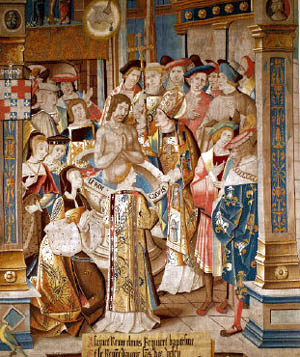
The Baptism of Clovis at Reims in 508 |
When we are born, Baptism removes the stain of Original Sin inherited from our first parents. Then when the age of reason arrives, Confession and Communion are available to help a child to confess his sins and thus to be made worthy to receive Our Lord in the Blessed Sacrament. Soon after, we receive Confirmation - a Sacrament that strengthens a soul to make him strong in the preservation and defense of his faith – a soldier of Christ.
Matrimony gives the grace to help a couple be faithful and bring up their children in fear and love of God; Holy Orders is for those who are called to be priests. At the very end of our lives, Extreme Unction forgives sins and gives strength for the final fight before death. One can see the loving hand of God for mankind in this beautiful system of Sacraments.
The sacramentals were not instituted by Our Lord, like the Sacraments, but by the Church in order to increase our respect for the latter or to give us special favors. The sacramentals do not produce grace by themselves, but they prepare our spiritual dispositions to receive it.
What sacramentals are directly linked to the Sacraments?
Linked to Baptism are the following sacramentals: the Sign of the Cross, holy water, the blessing of the baptismal fonts, by extension the blessing of the holy water fonts, the special exorcisms at Baptism that may be used on other occasions, the blessed candle that the godparents carry, etc.
Penance or Confession: the ashes, the prayers of contrition, the penitential psalms, the blow of the stick from the Roman Penitentiaries.
Holy Eucharist: the blessing the priest gives with the Holy Sacrament, the incense, the gesture of the priest striking his chest as a sign of humility, the prayer the Pater Noster, the last Gospel and the last blessing at Mass.
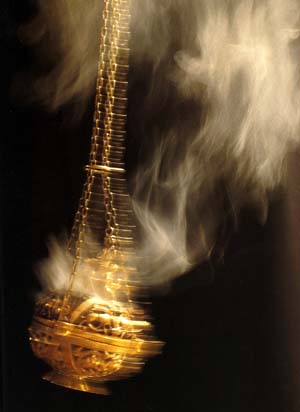
God told Moses to offer incense twice a day in front of the sanctuary |
It is during Mass that most of sacramentals are made, such as the blessing of the holy oils, the consecration of Bishops, the blessing of Abbots and Abbesses, the consecration of virgins (religious women), the profession of monks, the consecration of Kings and Queens, the nuptial blessing with the related blessing of the rings, etc.
It is also in relation to the Mass – before, during, or after it – that other blessings are made, such as the blessings of the ashes, candles, olive or palm tree branches, Easter lamb, Agnus Dei (by the Pope in Rome), blessed bread at the Offertory which is distributed to the faithful after Mass.
Related to the Mass are also the blessings of pipe organs, bells, chalices, altar cloths, the first stone of a new church, the pilgrims visiting a church, etc.
Confirmation, Extreme Unction and Holy Orders: linked to these three Sacraments is the blessing of the holy oils – the Holy Chrism, the unction for the sick, and the holy oil for the consecration of the Bishop. These are also considered sacramentals: the imposition of the hands, the slap on the face, the prayers and exorcisms for the dying, the prayers for deceased, various funereal prayers, the blessing of the cemeteries, tombs, and crosses of the graves.
Now, let me enter into more detail on some of the more common sacramentals that came to be used outside the ritual of the Sacraments in order to help us in our daily spiritual life.
More common Sacramentals
The Sign of the Cross – both the formula that we say and the sign we make – is the chief sacramental used in the Church. When we make the Sign of the Cross we profess our belief in the chief mysteries of the Catholic Faith. It expresses the mystery of the Incarnation by reminding us that the Son of God became man to suffer death on the cross for our redemption.
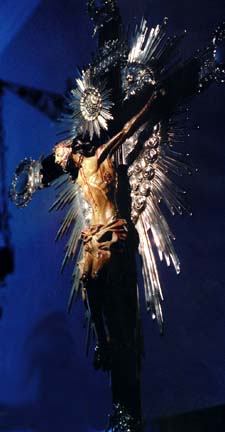
The crucifix reminds of how Our Lord suffered to redeem mankind |
We make the sign of the cross before we pray to recollect ourselves and to fix our minds and hearts on God. We make it when we finish praying to thank God for the gifts received. In temptations we make the Sign of the Cross to be strengthened; in dangers, to be protected.
The Spanish people use to precede the words of the Sign of the Cross with this beautiful invocation: "By the sign of the Holy Cross deliver us from our enemies, O, God Our Lord! In the name of the Father, and of the Son, and of the Holy Ghost, Amen, Jesus.”
Crucifixes, like the Sign of the Cross, remind us of how Christ suffered and died to redeem mankind. Of all the sacramentals, we venerate the crucifix the most. It is the sign of our redemption; a graphic, pictorial representation of the love of our Savior. It keeps before our minds the incalculable price paid for us and our reciprocal duty to Him. It fosters an all important tone of seriousness to our lives and in our families. It should occupy the place of honor in every Catholic home and accompany us in every step of our life until it is placed in our dying hands.
Holy Water is used especially to protect against evil spirits. It is an important part of the rite of exorcism because devils are notoriously unable to bear it and cannot be near it. St. Teresa of Avila said, “From long experience I have learned that there is nothing like holy water to put devils to flight and prevent them from coming back again. They also flee from the cross, but return; so holy water must have great value.”
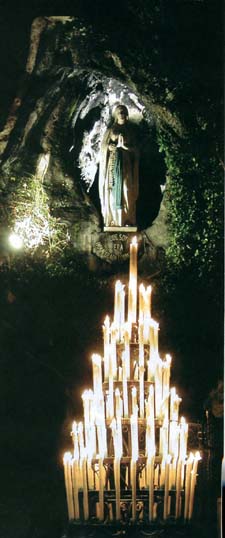
Candles burning before Our Lady at the grotto at Lourdes |
Blessed Candles are another beautiful tradition used by the Church in the Sacraments and other devotions. God made use of fire and flames many times in the Old and New Testaments. He appeared to Moses in the form of a fiery bush; the Holy Spirit descended on the Apostles in the form of fiery tongues; and Christ is often referred to as the “light of the world to enlighten them that sit in the darkness and the shadow of death.” The lighted candles remind us of all this. They have the effect of expelling devils and bringing blessings to the places were they are lighted.
The prayer that the priest says for the blessing of the candles is beautiful:
“O Lord Jesus Christ, Son of the Living God, we implore Thee to bless these candles and through the power of the holy Cross, to bestow upon them Thy heavenly benediction, who has given them to mankind to dispel darkness.
"May they, through the sign of the Holy Cross, obtain such blessing that wherever they may be lighted or wherever they be placed the powers of darkness may vanish, trembling and affrighted, with all their aids and accomplices and be driven from these dwellings, and never again dare disquiet or molest them that serve Thee, Almighty God.”
Blessed candles are made with pure beeswax to symbolize the pure flesh of Christ received from His Virgin Mother; the wick symbolizes the soul of Christ, and the flame that emits light and heat, His Divinity. During exposition of the Blessed Sacrament, the Host is surrounded by candles. A sanctuary lamp burns continuously before all tabernacles to honor His Divine Presence.
Many pious Catholics light votive candles as a symbol of their prayers rising constantly before the throne of God, Our Lady, or the specific Saint to which he is praying. Candles add beauty, symbolism and solemnity to all the liturgical functions.
Sacramentals not related to the Sacraments
Other times the Church institutes sacramentals that are not linked to the Sacraments, such as the Rosary, the Scapular, medals, the prayers of the Angelus, the Little Office of the Virgin Mary, or other special prayers, litanies, and ejaculations.
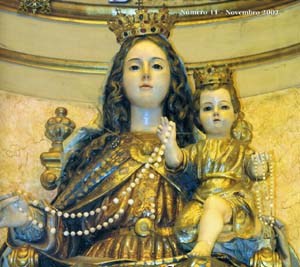
With the Rosary, we meditate on the lives of Our Lord and Our Lady |
The Rosary was given to us by Our Lady and was instituted by the Church as a most familiar and powerful Sacramental. Some criticize it as a mindless repetition of words but that is because they do not understand this great prayer. They are right in the sense that the repetition should not be automatic. They are wrong, however, to criticize it.
As they pray the decades of Hail Marys, Catholics are taught to meditate on the mysteries of the Rosary, which glorify the life, passion and resurrection of Our Lord as well as the life and glorification of Our Lady. It is an efficient and pious way to unite ourselves to Our Lord and Our Lady and a powerful instrument to attain the graces for ourselves and our neighbors that we are praying for.
Our Lady also promised the invaluable grace of final perseverance to those who habitually pray the Rosary. Many great miracles have been attributed to the Rosary devotion – some even changing the course of History, as in the case of the Battle of Lepanto[click here].
The Scapular another important sacramental, originated as part of the religious habit as a piece of cloth that fit from shoulder to shoulder (scapula is Latin for shoulder), went over the head, and draped over the front and back of the habit.
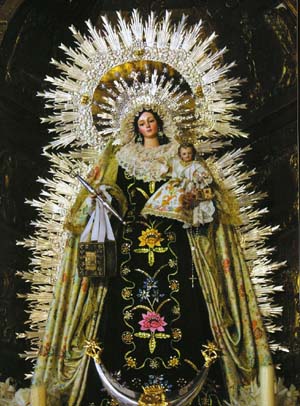
Our Lady of Mount Carmel in the brown scapular in Seville, Spain |
The Carmelite Scapular, which we Americans call the “Brown Scapular,” was established by Our Lady herself when she appeared to St. Simon Stock in 1251 and spoke these words regarding its use: “This shall be a privilege for you and all Carmelites that anyone dying in this habit shall not suffer eternal fire.”
With time the Church extended this magnificent privilege to all the laity who are invested in it and meet certain conditions. When a person is enrolled in the Confraternity of the Carmelite Scapular and vested in the small piece of brown wool, the priest says to him:
“Receive this blessed Scapular and ask the Most Holy Virgin that, by her merits, it may be worn with no stain of sin and may protect you from all harm and bring you into everlasting life.”
The Blessed Virgin assigned certain conditions which must be fulfilled to receive this privilege: 1.The scapular must be worn continuously; 2. the wearer must observe chastity according to his/her state in life; 3. the wearer must daily recite The Little Office of the Blessed Virgin Mary. The Church permits this devotion to be substituted with any one of the following: to observe the fasts of the Church, to daily recite five decades of the Rosary, or with the permission of a priest to do a good work. There is no substitute for the first two conditions. Pope Benedict XV granted 500 days indulgence for devoutly kissing your scapular.
Today the laity wears the scapular under their clothing. It is personal expression of their devotion to Our Lady and a reminder of their commitment to chastity. There are many stories of miracles linked to the wearing of the Scapular.
Following this example of the Carmelite Scapular, other scapulars were instituted by the Church in order to bring this or that specific privilege or protection to the faithful.
Medals are blessed objects that assist the wearer who has faith and tries to live a life of virtue.
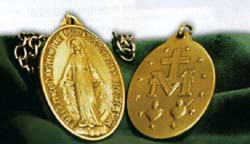
The miraculous medal |
The Miraculous Medal, for example, was struck from the explicit instructions of Our Lady herself. She appeared to St. Catherine Labouré in 1830 and gave her precise instructions about a medal she wanted distributed and a devotion established in honor of her Immaculate Conception. She promised many miracles where the medal was worn and the devotion established. One such miracle was the conversion of the French Jew named Alphonse Ratisbonne in 1842 [click here].
The St. Benedict Medal is another sacramental that is placed in the homes of the faithful to deter the powers of evil as in storms, poisons, pestilence, demonic infestations, and to encircle it with heavenly protection.
These are just some of the more common sacramentals of the Church that protect us and help us to love and serve God more. The sacramentals are companions and accessories to the Sacraments and incentives for the spiritual life. They arouse devotion and confer protection through the prayer of the Church.
They create in our souls pious dispositions that prepare us to receive graces from God, they also remit temporal punishment, grant health of body and material blessings, and protect from evil spirits.
Some ask where the Church traces her authority to attach such rich graces to these articles? The Church is the treasurer of all the merits of Christ’s Life and Death. She can apply those merits in the way she sees will most benefit mankind. Our Lord says “And I say to thee that thou art Peter (Cephas), and upon this rock (Cephas) I will build my church and the gates of hell shall not prevail against it – I will give thee the keys to the kingdom of heaven and whatsoever you shall bind on earth shall be bound in heaven, and whatsoever you shall loose on earth, it shall be loosed in heaven. (Matt. 16: 18-19). There can be no doubt that He was giving authority to His Church to do these things.
It seems to me that it is foolhardy to the extreme to ignore the treasure chest of blessings and advantages offered to us through the practice or the use of sacramentals. They are there for our benefit. One would have to wonder who could possibly neglect these gifts from Heaven.

Posted December 3, 2005

Related Topics of Interest
 Snowflakes Reflect the Diversity of God Snowflakes Reflect the Diversity of God
 The Symbol of the Crown in the Reign of Mary The Symbol of the Crown in the Reign of Mary
 The Symbol of the Sword in Today’s Defense of the Church The Symbol of the Sword in Today’s Defense of the Church
 Remember Lepanto! Remember Lepanto!
 The Symbol of the Chalice in the Garden of Olives The Symbol of the Chalice in the Garden of Olives
 Votive Candles, Fire, and the Love of God Votive Candles, Fire, and the Love of God
 The Symbolism of Spring The Symbolism of Spring

Related Works of Interest
|
Catholic Customs | Religious | Home | Books | CDs | Search | Contact Us |
Donate

© 2002- Tradition in Action, Inc. All Rights Reserved
|
 |
|